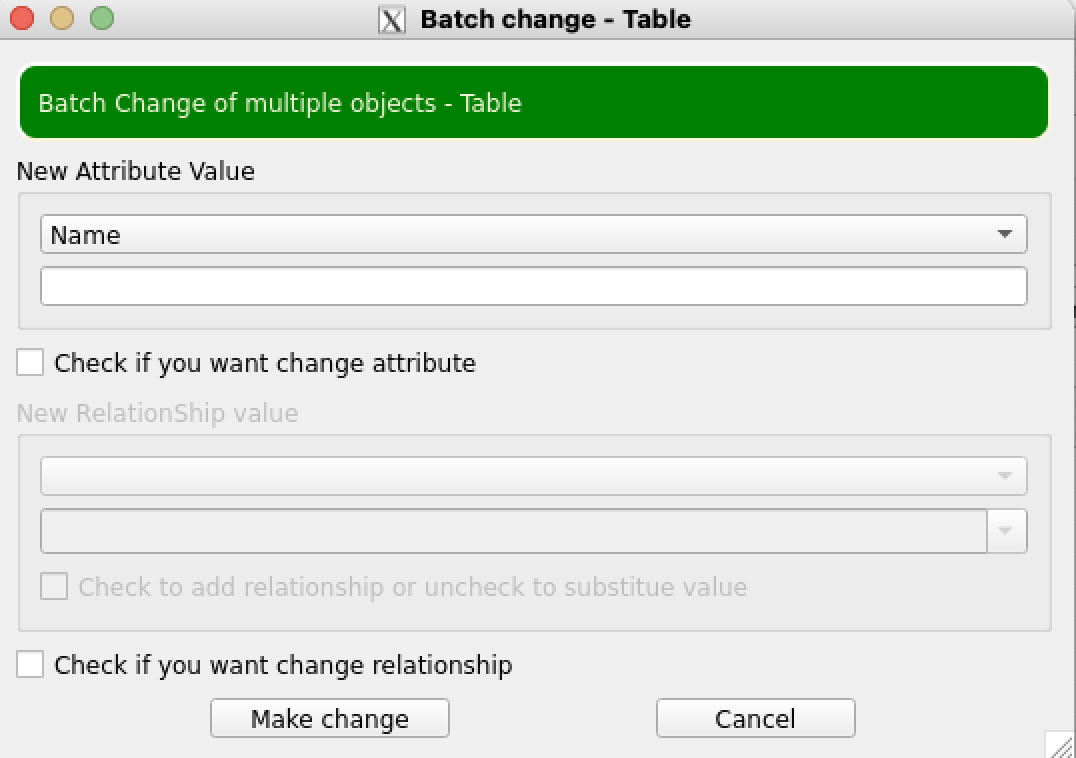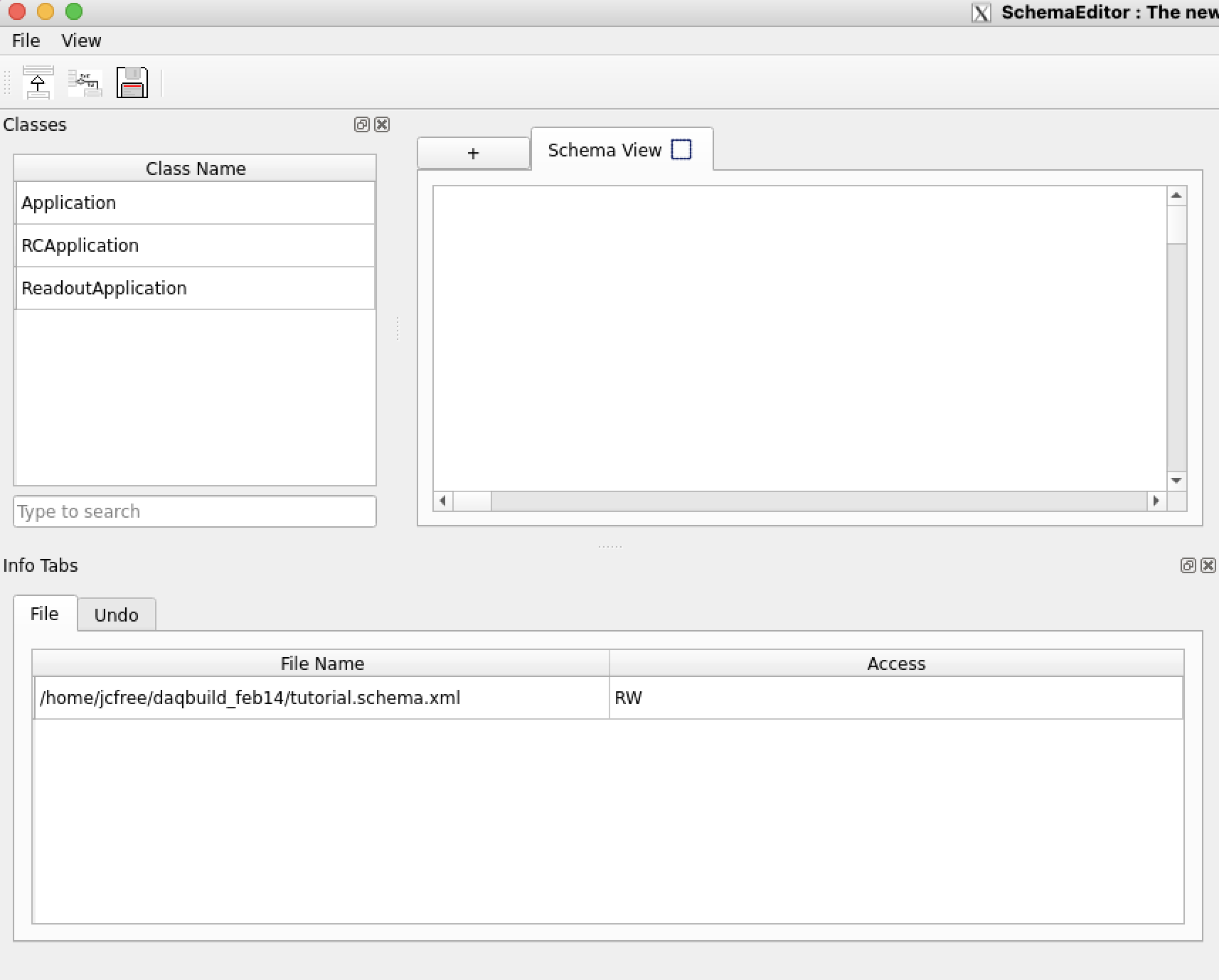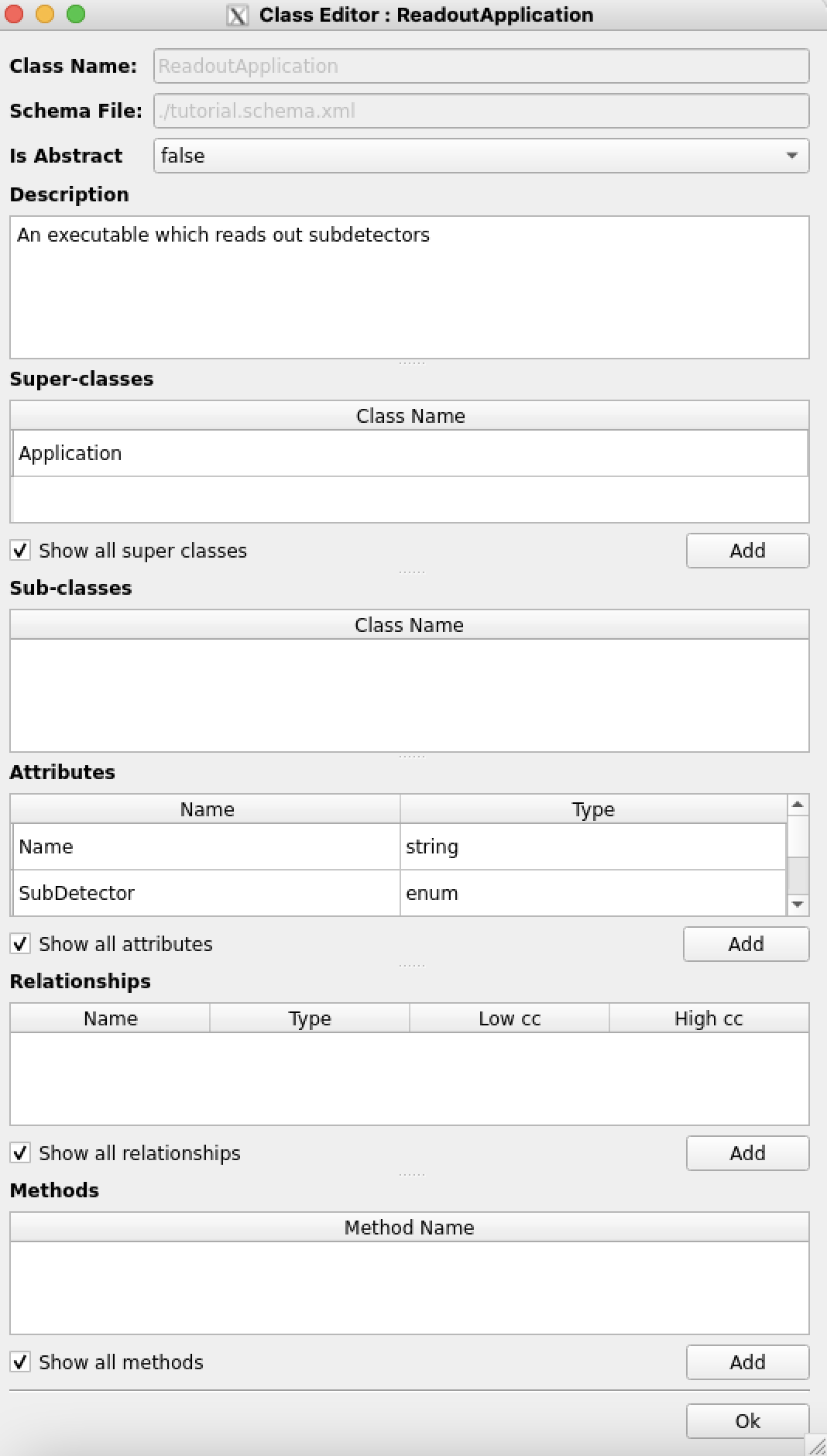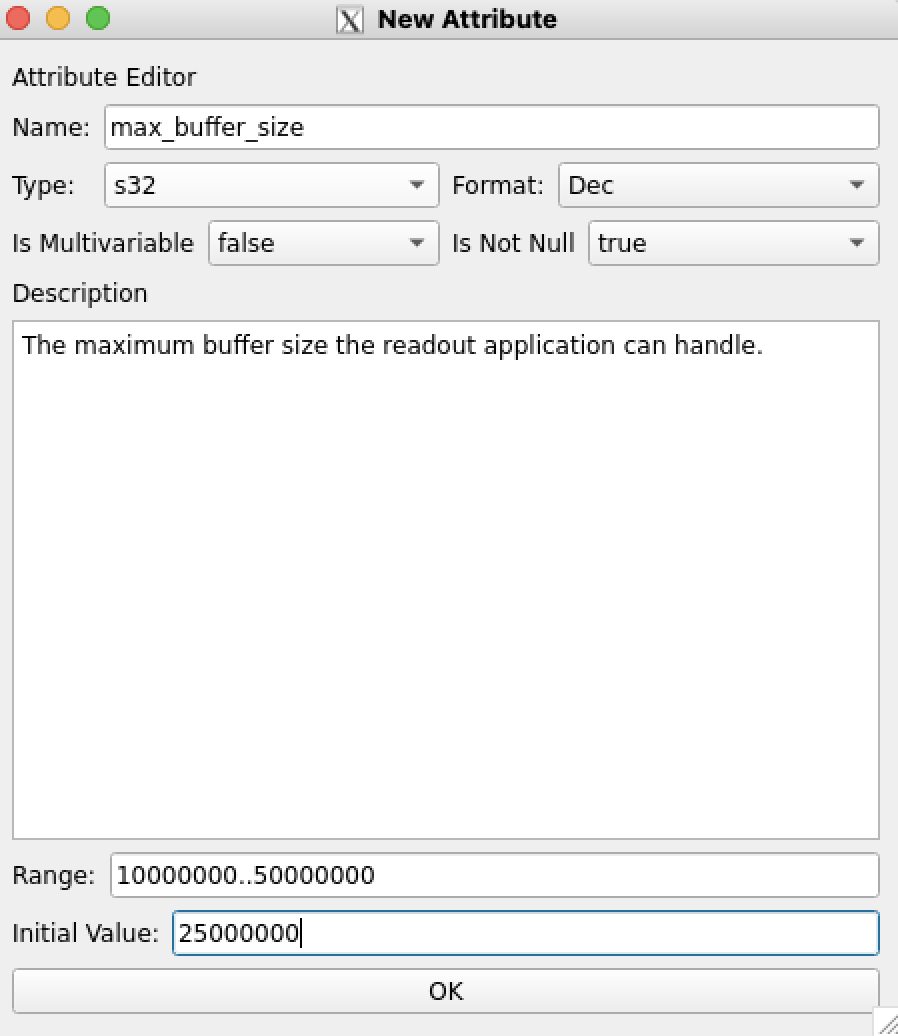DBE (DataBase Editor)¶
Intro¶
The DBE package provides a GUI interface to the OKS suite, allowing you to edit both schema files and data files. Note that these instructions will assume you have a basic familiarity with OKS as described here. They also assume that you know how to download and build repositories and are able to display windows from your command line (e.g. xclock & or emacs & pop up windows for you).
While DBE was originally written as part of the ATLAS TDAQ effort, it has been modified to build within the DUNE DAQ framework. To get started working with DBE, you'll need to do two things. (1) load in the core OKS packages by setting up a work area, and (2) run spack load dbe. This second command is needed since loading in dbe will cause emacs to no longer work in the terminal, an undesirable side effect developers don't want to have to experience whenever they set up a work area for reasons unrelated to dbe.
Walkthrough, Part 1: Editing Objects in a Configuration¶
Let's get started seeing what functionality DBE provides. A useful tutorial is provided by the dal package; as dal isn't part of the nightly build, you'll need to clone it into your sourcecode/ area and build it. Once you've done this, you can do the following:
tutorial.py # Generates a data file, tutorial.data.xml, which we can use for educational purposes
dbe_main -f tutorial.data.xml
First, a word on how the OKS system knows where to find XML database files like tutorial.data.xml. As you can see from the example above, it knows to search the current working directory. However, it also searches the colon-separated directories in an environment variable called DUNEDAQ_DB_PATH. The dbt-workarea-env command provided by daq-buildtools which refreshes your development environment will automatically add the schema directories from repos in your work area. Furthermore you can manually specify a different directory in your account (e.g., export DUNEDAQ_DB_PATH=$HOME/oks_config_files:$DUNEDAQ_DB_PATH) if you want a common location for your OKS schema and data files.
tutorial.data.xml describes a very simple DAQ system which consists of one run control, one TPC readout application and one photon readout application; it's covered more thoroughly here. When DBE launches, you'll see a subwindow on the left side of the DBE window titled "Class View". As you can see, this lists the classes available to the data file you provided DBE, as well as the number of objects of each class type. Click on ReadoutApplication, and you'll see the following:

...i.e., we have a toy readout application for photon detection and a toy TPC readout application.
Let's open a second terminal and edit the tutorial.data.xml file. Take the TPCReadout object at the bottom of the file, i.e.
<obj class="ReadoutApplication" id="TPCReadout">
<attr name="Name" type="string" val="/full/pathname/of/readout/executable"/>
<attr name="SubDetector" type="enum" val="WireChamber"/>
</obj>
TPCReadout into TPCReadout2; OKS requires that each object has a unique ID. Save the file. You should see two things have changed in the GUI: (1) a message saying Database reloaded due external changes and (2) the addition of the second TPC readout application which you created. DBE keeps track of edits to the XML database file, and notices when it's been changed. Hit OK in the message to close it.
Now let's perform some edits within the GUI. First, as an example of how you can change a variable across multiple objects, do the following: click on the text box titled Table Filter below the list of readout object. Our three objects have the IDs PhotonReadout, TPCReadout and TPCReadout2. Let's change the name of the TPC readout executable. Type TPC and you'll see that DBE is now displaying only the two objects whose names begin with those three letters. Click on the Edit option in the upper left of the window and select Batch Change Table. You'll see a window like the following pop up:

While there's a dropdown menu for New Attribute Value, let's stay with the Name attribute value for editing purposes. In the text box directly below the dropdown menu, you can enter any string, e.g. /new/name/of/tpc/readout/executable. Then check the checkbox Check if you want to change attribute (unclear why ATLAS required this) and click the button Make change at the bottom of the window. You'll see the value update in the main DBE window. If you delete the TPC from the Table Filter text box you can return to the full listing of readout objects.
Let's now make changes to the run control application. In the Class View pane on the left side of the window, double click on RCApplication. You'll see that the run control application (ID DummyRC) has replaced the readout applications in the table on the right. Under the Object Name column header, double click on the boldface DummyRC, and a window will pop up which looks like the following:

If you double click on Type here in the Applications Controlled section, you have the option of adding an application under run control. You can do so either by typing the ID of the application, or - easier - clicking on the little down arrow that's appeared on the right and selecting the application you want to add. Afterwards, if you click on the 20 for the Timeout, you can change its value. For fun, see what happens if you try to save a value greater than 3600. Play around with edits as you wish and then click the Apply button at the bottom of the window, followed by Close.
At this point, let's save our work. Back in the main window of the database editor, near the upper left hand corner, click on the icon which looks like the following: ![]() Enter a commit message and hit
Enter a commit message and hit OK, you should see another window pop up saying List of modified files committed to the database. Hit OK in that window. Then navigate to the File drop down in the far upper left of the main window, and select Exit. We're done editing the configuration for now; now we'll edit an actual class.
Walkthrough, Part 2: Editing Classes in a Schema¶
First things first: since the schema file off of which tutorial.data.xml is based in cvmfs, we can't edit it directly. So instead we'll copy it over:
cp $DAL_SHARE/schema/dal/tutorial.schema.xml .
tutorial.data.xml so it points at the copied schema file, not the original:
sed -r -i 's!.*tutorial.schema.xml.*!<file path="./tutorial.schema.xml"/>!' tutorial.data.xml
schemaeditor -f ./tutorial.schema.xml

Let's add an Attribute to the ReadoutApplication class. In the Class Name pane on the left, double click on ReadoutApplication. A new window will pop up which looks like the following:

In the Attributes section of the window, double click on the Add button. Another window, this one called New Attribute, will pop up. You can fill it in, e.g., like so:

where I've defined a max_buffer_size Attribute, which you can set anywhere from 10 MB to 50 MB, with a default value of 25 MB. Please note the dropdown menu selections of data type (4-byte integer) and the setting of Is Multivariable to false; when set to true OKS would expect a list, not a single value. Click OK to save your changes. Then click OK to exit out of the class editor window. Finally, click on the File drop down list in the upper left hand corner of the main window and select Save Schema. Then exit out, by selecting Exit from the same drop-down menu. On exiting out, you may be again prompted to save the schema, in which case save it again; this suggests there may be an issue with the regular Save Schema option.
You can now see the changes you've made, whether by opening up tutorial.schema.xml or by re-running dbe_main -f tutorial.data.xml and looking at ReadoutApplication instances.
Creating A Diagram of Your Configuration¶
A discussion of DBE wouldn't be complete without mention of its diagram-creation tool, dbe_gtool. E.g., to create a diagram of the configuration we've edited in this tutorial, you can do the following:
tmpfile=$( mktemp )
dbe_gtool --file ./tutorial.data.xml --result $tmpfile
dot -Tsvg $tmpfile > tutorial_diagram.svg
tutorial_diagram.svg using, e.g., gimp or your web browser. Please note that depending on the display tool you choose you may need to display the diagram from a different terminal than the one in which you have your work area set up due to compatibility issues with the cairo package which Qt depends on. The diagram will look something like the following:

Last git commit to the markdown source of this page:
Author: John Freeman
Date: Thu Apr 18 16:04:24 2024 -0500
If you see a problem with the documentation on this page, please file an Issue at https://github.com/DUNE-DAQ/dbe/issues